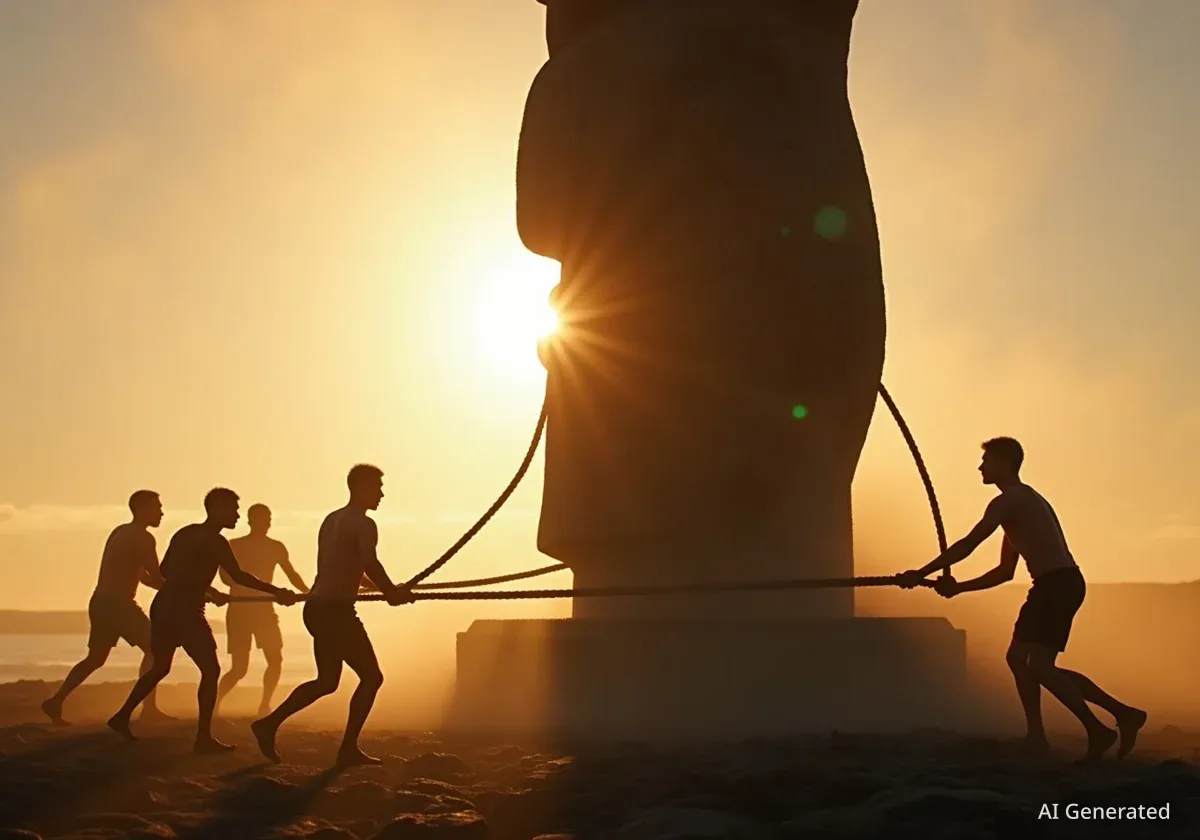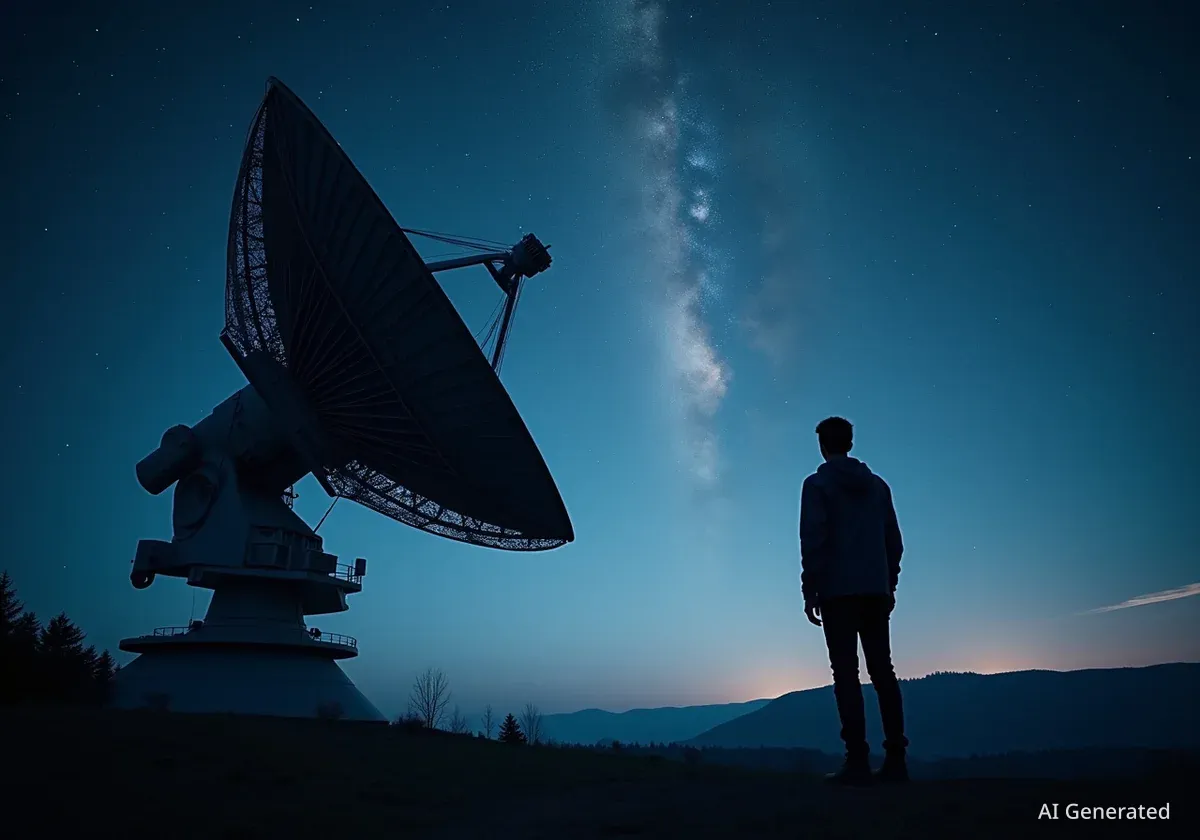A new study published in the Journal of Archaeological Science provides compelling evidence for how the giant moai statues of Easter Island were moved. Researchers combined 3D modeling and physical experiments to demonstrate that the island's inhabitants used a coordinated rope-pulling technique to make the multi-ton statues "walk" upright to their final destinations.
Key Takeaways
- Archaeologists used 3D models and a full-scale replica to test the "walking" hypothesis for moai transport.
- Statues intended for transport had wider bases and a forward lean, making them inherently unstable but ideal for a rocking, walking motion.
- An 18-person team successfully moved a 4.35-ton replica 100 meters in just 40 minutes, supporting the theory.
- The statues were modified for stability only after reaching their ceremonial platforms, which erased the features that enabled movement.
The Enduring Mystery of the Moai
For centuries, the massive stone statues, or moai, of Easter Island (Rapa Nui) have puzzled scholars. Carved from volcanic rock around 800 years ago, these figures, some weighing up to 92 tons, were transported across the island to be placed on ceremonial platforms known as ahu. The central question has always been how a Stone Age culture managed such a monumental engineering feat.
One long-standing theory, supported by the oral traditions of the Rapa Nui people, suggests the statues "walked" from the quarry. Archaeologist Carl Lipo of Binghamton University has been a prominent advocate of this hypothesis. His latest research aims to provide definitive physical proof to support these cultural accounts.
Previous Research and Experiments
This is not the first time the walking theory has been tested. In 2012, Lipo and his colleague Terry Hunt demonstrated that a 5-ton moai could be moved by a small team. However, Lipo noted that the experiment, filmed for a documentary, lacked rigorous scientific predictions. Earlier, in the 1980s, Czech archaeologist Pavel Pavel also conducted tests, but his method resulted in a less efficient "shuffling" motion.
Designed for the Journey, Not the Destination
The new study presents a crucial distinction between two types of moai: those found abandoned along ancient roads and those successfully erected on platforms. Lipo and his team compiled a database of 962 statues and performed detailed analysis, focusing on 62 "road moai."
Unique Characteristics of Road Moai
The analysis revealed that road moai were engineered specifically for transport. They possess distinct features that differ from the statues found on platforms.
- Wider Bases: Compared to their shoulder width, the bases of road moai are significantly wider. This design lowers the statue's center of mass, providing a stable foundation for a side-to-side rocking motion.
- Forward Lean: These statues have a consistent forward tilt, ranging from 6 to 15 degrees. This intentional lean causes the statue to fall forward with each rock, creating a "step." The rounded front edge of the base acts as a pivot point.
In contrast, the statues that reached their destination were modified. Carvers would reshape the base to remove the lean, shifting the center of mass to create a stable, upright figure. The iconic eye sockets were also carved only after the moai was permanently installed on its ahu.
"Our contribution builds on this by showing that ancestral engineers intentionally designed statues for walking. Those statues were later modified to stand erect on ceremonial platforms, a transformation that effectively erased the morphological features essential for movement," Lipo and Hunt wrote in their paper.
Recreating the Ancient Method
To test their findings, the research team created a precise, 4.35-metric-ton replica of a road moai, matching its mass distribution and proportions. The goal was to move beyond simple proof-of-concept and analyze the physics of the process.
The Field Test by the Numbers
- Weight of Replica: 4.35 metric tons (9,590 lbs)
- Team Size: 18 people
- Rope Configuration: 3 ropes (one on each side, one at the rear for control)
- Result: Moved the statue 100 meters in 40 minutes
The experiment demonstrated that the method is highly efficient. It relies on pendulum dynamics and resonance. A larger group might be needed to initiate the rocking, but a smaller, coordinated team can sustain the motion with minimal effort, primarily guiding the statue's steps.
"Through physics, we can now predict how many people it would take and how it would be done," Lipo stated. "That is key." The model suggests that even the largest moai could have been moved by crews of 20 to 50 people, a size consistent with an extended family group on the island.
Evidence Carved into the Landscape
Further evidence supporting the walking hypothesis comes from the island's ancient roadways. Lipo and Hunt's analysis of these paths revealed they have concave cross-sections.
This shape would have been a significant obstacle for any horizontal transport method, such as rolling the statues on logs. However, for a statue being walked upright, the concave road would act as a guide, helping to constrain the side-to-side rocking motion and keep the moai on course.
The roads are also remarkably level, with average slopes of only 2-3 percent. The team's experiments showed that even steeper inclines could be managed with controlled stepping, allowing the moai to be moved up ramps onto the ahu.
Challenging Alternative Theories
Over the years, some scholars have proposed that the road moai were not failed transports but were placed intentionally for ritual purposes. Lipo argues that the mechanical failure explanation is more scientifically sound and falsifiable.
"There is no reason why the places the statues fell due to mechanical reasons couldn't later become 'ritual,'... But to argue that they were placed there purposefully for ritual purposes demands framing the explanation in a way that is falsifiable," he explained.
Lipo emphasizes the importance of experimental archaeology when it is grounded in physics and chemistry. He believes this approach allows researchers to build cumulative knowledge and move beyond speculation.
"Physics and chemistry are our time machines, allowing us to explain why things are the way they are in the present in terms of the events that occurred in the past," Lipo said. This new study represents a significant step in using modern science to solve one of archaeology's most captivating puzzles.





